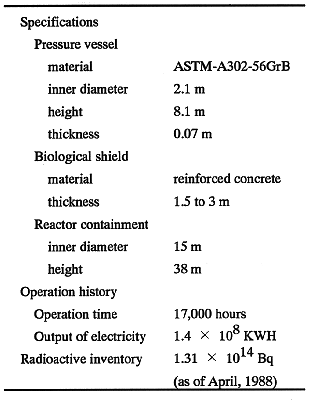
Mitsugu Tanaka, Satoshi Yanagihara and Yoshihiro Seiki
Japan Atomic Energy Research Institute
2-4, Shirakata-shirane, Tokai-mura,
Ibaraki-ken, 319-11, Japan
Phone : 81-29-282-6388, Fax : 81-29-282-5998
ABSTRACT
The Japan Power Demonstration Reactor (JPDR) decommissioning program was successfully completed by March 1996. This was the first trial to dismantle a nuclear power plant in Japan. The program consisted of two phases: Phase I was the R&D on decommissioning technologies, and Phase II was the actual dismantling of JPDR facility. Especially efforts were made to develop various kinds of dismantling techniques. The developed techniques in the Phase I program were practically applied to actual dismantling activities. The usefulness of the developed techniques was verified through the dismantling activities. Various know-how and data was collected in the dismantling activities and these were accumulated in the decommissioning database. The data and lessons learned in the JPDR decommissioning program will be useful for future decommissioning of commercial nuclear power plants in Japan.
INTRODUCTION
The Japan Power Demonstration Reactor (JPDR), which was a BWR type nuclear power plant, generated electricity in October 1963 for the first time in Japan. Following the electricity generation by the JPDR, the first operation of commercial nuclear power plant (Tokai power station) started in 1966. Since then, capacity of nuclear power in electricity increased steadily, and 49 nuclear power plants are operating in Japan so far. The nuclear power is indispensable source for electricity in Japan. However, since the life time of nuclear power plants is expected to be 30 to 40 years, some older nuclear power plants will get into the age of considering decommissioning in the early 21st century.
In considering the future decommissioning of nuclear power plants, the basic policy for decommissioning of nuclear power plants was decided by Atomic Energy Commission in Japan. It was described in the long-term program for research, development and utilization of nuclear energy issued in 1982. It states that dismantling of retired nuclear power plants should be performed as early as possible after its shutdown and the site should be effectively reused for the next generation of the nuclear power plant. It also pointed out the necessary of studies on wide-ranging technologies for future decommissioning commercial nuclear power plants.
After various kinds of experiments on power reactors and the demonstration operations for about 10 years, the JPDR was finally shutdown 1976 due to several problems. Through the discussion on restart of the JPDR, it was finally decided that the JPDR would be applied to the test facility for demonstration of decontamination and decommissioning (D&D) technologies. Based on the policy on decommissioning, the JPDR decommissioning program was initiated in 1981 by the Japan Atomic Energy Research Institute under contact with the Science and Technology Agency of Japan.
The JPDR decommissioning program was divided into two phases : technology development (1981-1986) and actual dismantling of JPDR (1986-1996). The objective of this program was : to develop various techniques necessary for reactor decommissioning, to obtain experience on dismantling activities, and to develop a decommissioning database relating to techniques and dismantling activities.
The JPDR decommissioning program was completed by the end of March, 1996 after demonstrating complete dismantling of the facility. Various data and experiences were accumulated through the JPDR dismantling activities.(1)
TABLE I Major Specifications, Operation History and
Radioactive Inventory of JPDR
JPDR
The JPDR is a BWR type demonstration reactor, of which power was initially 45 MWt (JPDR-I). It first generated electricity in October 1963, and it´s operation was continued by 1960. After that, the JPDR was improved to increase the power to 90 MWt for enhancement of the neutron irradiation capability (JPDR-II). The JPDR-II was finally shutdown in 1976 due to several problems such as cracking of the nozzle part of the in-core monitor tube and failure of the control rod drive mechanism. The total operation time and output of electricity were about 17,000 h and 1.4 108 kWh (440 FDD), respectively. Table I shows the major specification and operating histories of the JPDR. The JPDR had greatly contributed to developing nuclear energysuch as manufacturing of domestic nuclear fuels and taking measure of stress corrosion cracking through experience of various troubles.
Table II Dismantling Techniques developed in The JPDR
Decommissioning Program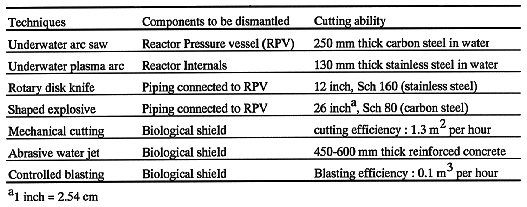
JPDR DECOMMISSIONING PROGRAM
Technology Development
In the technology development phase, eight items on R&D was selected for decommissioning of the JPDR.(2) These include decommissioning systems engineering approach, radioactive inventory estimation, remote dismantling, decontamination, radiation control, remote handling and radioactive waste treatment. Especially, various dismantling techniques with remote operation were developed in the program to be applied to the actual dismantling activities for minimization of radiation exposure of workers.(3)-(5) For examples, it was confirmed that the underwater plasma arc and arc saw could cut stainless steal of 130 cm thickness and carbon steal of 250 cm thickness, respectively. These results were enough to be applied to the actual dismantling activities. Table II shows the main results of development of dismantling technologies.
The techniques developed in the technology development program was almost applied to dismantling of the JPDR, and it was confirmed that these techniques were useful for future dismantling of commercial nuclear power plants.
Dismantling Activities
On the first stage of the JPDR dismantling activities, machinery around the reactor in the reactor building was removed to provide necessary space for installation and operation of the large remote operated cutting tools to dismantle the JPDR reactor itself. The dismantling of the reactor core part was then started using remote control machines. The major activities are described as follows.
The reactor internals were removed by the underwater plasma arc cutting system. The plasma torch was operated in the most cases by a mast type manipulator. First, each reactor internal was removed from the reactor pressure vessel (RPV) wall, the cut pieces were then transferred underwater to the spent fuel storage pool through the canal. These pieces were cut into smaller segments suitable for packaging using another underwater arc saw cutting system. Figure 1 shows schematic diagram of the underwater plasma arc cutting systems. The RPV was dismantled using the underwater arc saw cutting system. Before installing the underwater arc saw cutting system, a temporary cylindrical water tank was installed in the space between the RPV and the biological shield. The tank was filled with water to cut the RPV underwater. The top flange portion of the RPV body was cut vertically into 9 pieces. The other parts were cut into 8 horizontal pieces and 9 vertical pieces. The pieces were washed by a water jet above the water surface before being put into containers. No significant radioactivity in the working environment was observed during the dismantling activities.
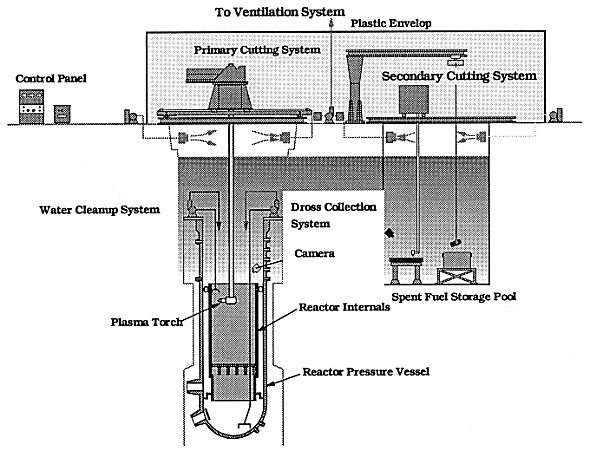
Fig. 1. Schematic diagram of
underwater plasma arc cutting system.
Following the dismantling of the RPV, the neutron-activated portion of the biological shield was dismantled using both the diamond sawing/coring and the abrasive water jet cutting techniques. Figure 2 shows schematic diagram of the biological shield, indicating radioactivity levels and the area classification. First the diamond sawing/coring, next the abrasive water jet cutting were applied to cut the upper and lower half of the projected portion of the biological shield, respectively. The controlled blasting was applied to the rest, which was only slightly activated. At first, the layer of 40 cm width from the inner surface was dismantled. The wastes were put into containers for storage. The outer layer of the biological shield was dismantled by both the controlled blasting and conventional tools. The concrete waste in the outer layer was disposed of in the near surface burial place in JAERI´s site, as the first test case.
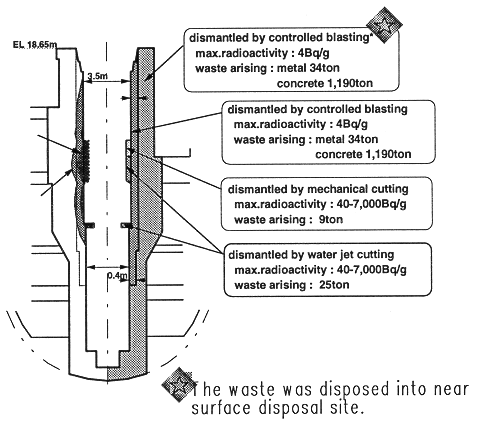
Fig. 2. Area
classification of JPDR Biological Shield.
Final Radiation Survey on Building Surface
After removing components, the building surfaces were decontaminated by various techniques such as plainer, scabblar and breakers. To conduct decontamination efficiently, contamination was characterized by in-situ measurement and taking samples. The survey of contamination characteristics showed that the penetrated contamination was within a few mm and less than 20 mm for 60Co and 136Cs, respectively at the area where there was a record of release of primary coolant. Based on the data, the building surfaces were decontaminated using various tools.
The decontamination work was conducted in different manners depending on the contamination depth. In the area where only surface contamination was observed, the surface layer of a few mm depth was segregated. On the other hands, the area where penetrated contamination was observed, segregation of surface layer and measurement of radioactivity was repeated in each process. When the no significant radioactivity was measured a layer of, 5 mm in depth was further segregated with a safety margin.
After all contaminated layers of building surfaces were removed, final survey of radioactivity was conducted to all building surfaces using handy type gas flow counter. The samples were also taken from every rooms to confirm that the radioactivity was less than 4 Bq/kg. Following the inspection of authorities, the controlled areas were canceled to demolish the building using conventional tools.
DATA COLLECTION AND ANALYSIS
The data on dismantling activities were systematically collected and these were accumulated in the decommissioning database. The database was used for
The data were collected on the data collection and retrieval systems. The JPDR dismantling data were basically grouped into three categories: radiation control data, dismantling operations data, and waste management data. The radiation control data, including working hours and external dose of workers, were collected using magnetic identification cards and pocket dosimeters. When passing through the gate of radiation control area, workers were required to keep records of entering/existing time and external dose by inserting their magnetic card and pocket dosimeter into a magnetic reactor connected to a minicomputer. The other data were collected in the form of description made by worker's supervisors. The other data such as machine performance and unexpected occurrence were stored as a form of documentation.
The radiation exposure of workers was one of the important data to characterized the dismantling activities. The total worker dose was measured to be 306 man*mSv, which was low enough to meet safety requirements. Figure 3 shows the breakdown of worker dose with regard to major dismantling activities. The most parts of worker dose were measured at the dismantling activities of installation of the water tank into the cavity between the biological shield and the RPV, and collecting of dross produced in cutting reactor internals. The major dose uptake occurred at hand-on work, even in the work which remote cutting machines were applied to. It was proved that detailed planning of dose control and estimation of dose rates at work areas were important to minimize unexpected worker dose in the dismantling procedures.
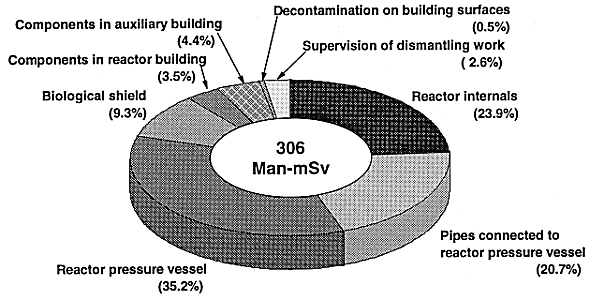
Fig. 3. Worker dose
in dismantling activities.
With regard to the waste, the total of 24,400 tons of waste including 3,340 tons of radioactive waste was produced in the all dismantling activities, as shown in Fig. 4. The extremely low level concrete waste was disposed into near surface burial place constructed in JAERI´s site. The concrete waste disposed in near surface burial place weighted 1,670 tons, which was 6.8 % of total waste.
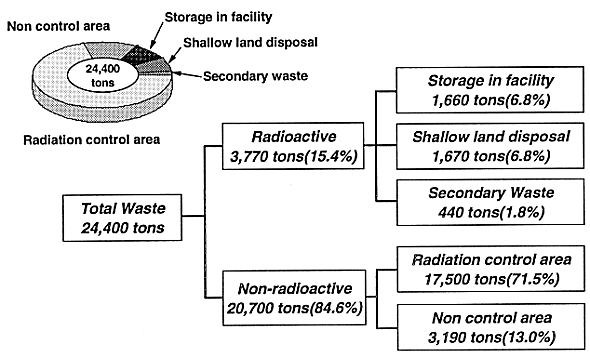
Fig. 4. Waste Arising
from Dismantling Activities
LESSONS LEARNED IN THE DISMANTLING ACTIVITIES
It was demonstrated that a nuclear power plant could be safely dismantled by ensuring safety of workers with suitable radiation control using the technologies developed. There was no impact to the environments such as unexpected release of radioactive materials due to the dismantling activities. Characterization of physical and radioactive inventory on the componentsto be dismantled was played an important role for safe dismantling activities. The radiation measurement and radioactive inventory estimation techniques were established through the program. The detailed studies on dismantling machines developed in the technology development phase was summarized as follows.
Underwater Plasma Arc Cutting
It was effective for work efficiency to take two separate steps in dismantling reactor internals. First, reactor internals were separated from the RPV wall by cutting. The cut pieces were transferred to the spent fuel storage pool. Then these were cut further smaller pieces for packaging. The observation by CCD cameras in two different angles were effective to decide plasma torch positioning. In addition, a small camera was necessary for observation at congested areas. Strippable painting was effective for protecting the contamination of dismantling devices which was used underwater.
Shaped Explosive Cutting
In cutting of pipes of which inner surface was contaminated at the level of 100 Bq/cm2, air contamination and blasting pressure at the service floor were measured to be less than 0.35 kg/cm2 and 70Bq/cm3, respectively, which were in the most rigorous conditions. The shaped explosive cutting was therefore proved to be applicable for cutting pipes in nuclear facilities with safe manner.
Rotary Disk Cutter
The forced circulation pipes were cut without serious problems by the developed disk cutter. The cutting records i.e. cutting depth vs. time were almost same as those obtained in the basic tests.
Underwater Arc Saw Cutting
The total cutting length and time were measured to be 100 m and 326 hours, respectively in dismantling the reactor pressure vessel. Since the cutting speed was devised to be 5.1 cm/min in average, it was different depending of the cutting region; average cutting speed was measured to be 0.83 cm/min in flange part, 6.3 cm/min in vertical cutting of main body, and 8.2 cm/min in horizontal cut of main body. In cutting of flange part, the cutting speed was reduced due to decrease of dross discharge efficiency. The total of 24 blades were used in cutting with 15 blades in vertical cutting and 9 blades in horizontal cutting. The average cutting length per one blade was 3.1 m in vertical cutting and 6.0 m in horizontal cutting.
Mechanical cutting
The upper part of the biological shield was demolished by removing blocks (5.7 tons) and 101 cores (3.1 tons) using sawing/coring methods. The total cutting time was measured to be approximately 260 hours, which was relatively low speed compared with the abrasive water jetcutting.
Abrasive Water Jet Cutting
By using the abrasive water jet cutting, 8 (4 tons) and 97 (24.7 tons) blocks were removed from the RPV support structure and the lower projected part of the biological shield. Since the abrasive was not reused, the total of 36 tons of abrasive was produced as a secondary waste. It will be necessary to consider the reuse of abrasive to reduce the volume of secondary waste.
Controlled Blasting
The total of 1,466 tons (~600 m3) of the biological shield was demolished by the controlled blasting with use of 172 kg explosives. It was observed that the blasting was almost within the planned region and it was effective to demolished the massive structures.
FUTURE DEVELOPMENT OF DECOMMISSIONING TECHNOLOGIES
In the progress of dismantling the core region in the JPDR dismantling project, the developed technologies such as remote handling, cutting, decontamination were verified to study further on D&D technologies. Based on the verification study, new program for development of D&D technologies have been started since 1990. The followings are the items to be studied in the program.
Decontamination techniques in consideration of minimizing waste arising Radioactivity measurement techniques; efficient measuring systems under high background conditions, measurement of radioactivity inside pipes embedded in structures, etc.
Remote dismantling techniques including; computer simulation of remote dismantling procedures and study on robotic manipulators
Systems engineering approach; development of expert systems for study on optimum decommissioning plan and decommissioning database
CONCLUDING REMARKS
The JPDR decommissioning program which was commenced April 1981 was successfully completed by the end of March, 1996. The JPDR decommissioning program has a unique feature to develop various kinds of dismantling techniques and to dismantle the facility by segmenting them into small pieces for packaging. Various systems with remote operation developed in the technology development phase were successfully applied to the dismantling of highly activated components. These techniques were proved to be useful to minimize radiation exposure of workers.
In the dismantling experiences and lessons learned on decommissioning were obtained and the data are being installed in the decommissioning database. The database and lessons learned will contribute to the decommissioning of commercial nuclear power plants in the future.
REFERENCES